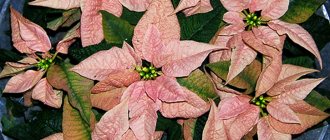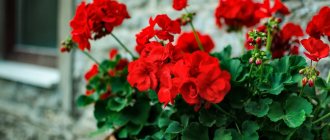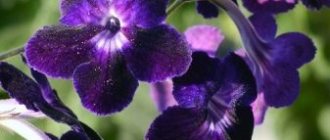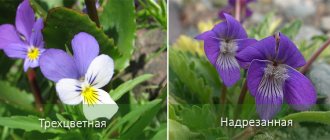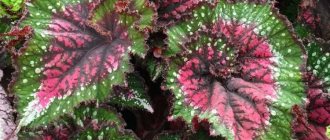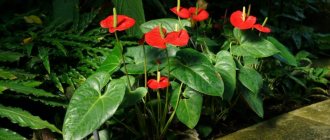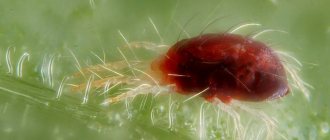Author of the article: Olga Viktorovna | Updated: 09-02-2022
Steklogram. Creative glass painting kit, 3D drawing. Starproject
700 ₽ More details
Creation of a painting String Art Lab Mountains, A4012
713 ₽ More details
Beige women's coats
Orchids belong to the large family of monocots. Under natural conditions, these beautiful flowers grow almost everywhere. Tropical latitudes are best suited for their development. Rare species of orchids are a dream for avid gardeners.
Dazzling living beauty
Orchids captivate with their grace and extraordinary tenderness. They are gradually replacing luxurious roses and other flowering plants. What makes home orchids so popular? Aristocratism, graceful silhouette, bright fragrant bouquets.
There are approximately 750 species of this flower. Their names are difficult to remember, but it is easy to highlight the most unusual and best of the best.
The Phalaenopsis orchid was studied by the botanist Blumen back in the 19th century. Their distinctive feature is a long stem with 4 fleshy leaves, and the inflorescences look like butterflies with velvety wings. In good conditions it can bloom 3 times a year.
This species has many varieties.
- Phalaenopsis Schiller has multi-colored leaves with a top coating. It can be distinguished by the large number of colors that gather on one branch. Sometimes there were 174 colors. Blooms 2-3 times a year.
- Amabilis is distinguished by large inflorescences that “sit” on winding branches. Up to 20 flowers grow on them, the diameter of which can reach 11 cm. The snow-white, yellow or pink-purple petals smell wonderful, which attracts flower growers.
- Stewart's Phalaenopsis has snow-white buds with reddish spots. This plant blooms in spring and autumn.
- Phalaenopsis Luddeman blooms at any time of the year, but most luxuriantly from December to March, and spreads an indescribable magical aroma around itself. Snow-white flowers cannot be confused with pink or yellow flowers.
- Pink, has a small peduncle with 15-20 snow-white pink flowers. But the elongated iridescent sepals, endowed with three lobes, have a transitional range from red to purple.
- The Sandera variety is the rarest and most expensive of the Phalaenopsis. The name is given by the surname of the gardener - Sander. The plant stands out with large peduncles looking down. They contain up to 50 flowers in diameter, reaching from 5 to 7 cm. Look at the photo.
- Phalaenopsis equina will suit fans of dark lilac and pink-purple colors.
- The giant one is distinguished by massive leaves reaching a length of up to 90 cm. The color of the flowers is milky cream, yellow and greenish-yellow, with protruding dark brown streaks. Due to the large size of the peduncle, it is difficult to keep at home, but for a greenhouse it is just right.
Cymbidium orchid: photo and features of the flower
The types of orchids grown in pots, familiar to gardeners from their photos and names, can have different sizes and structures. Cymbidium is one of the most interesting representatives of orchids in home collections. In nature, plants easily reach two meters in height. But not so tall varieties are used as green pets.
With a growth of 50 to 100 cm, the cymbidium orchid, as in the photo, reveals extremely bright and large flowers. The corolla of this plant can reach 13 centimeters in diameter, and there are simply countless color options for the powerful racemose inflorescences! The uniqueness of this genus is its long flowering, up to six months, as well as the aroma of some varieties.
Other varieties of orchids
Cattleya surprises with its beautiful transparent waxy bouquets. There are many varieties, as well as a varied palette of colors. It blooms for three months.
Cymbidium - takes root well at home.
Dendrobium can bloom at any time of the year. It is not afraid of even not very warm conditions; it can delight with flowering even at a temperature of 10 ° C.
No gardener will refuse to have in his collection this magnificent seedling in the form of a tree with unusual flowers covering the entire stem of the plant. Wild orchids grow on trees or rocks, which is why its name means “tree-dwelling.”
A popular species among gardeners is Dendrobium nobilis due to its low maintenance requirements. This is a rather large plant with fleshy stems, on which dense, oblong-shaped leaves are located in two rows.
On short peduncles, three flowers are formed, whitish-cream at the base and pinkish or lilac at the edges.
A very popular species among florists is Dendrobium phalaenopsis. It attracts with large flowers, with a diameter of 3 to 8 cm. Each peduncle can accommodate from 5 to 40 white or crimson flowers.
Cambria has durable flowers of varying sizes and configurations. To make the plant bloom profusely, place it on the windowsill.
Phalaenopsis orchid: photo and description
Most often, as an indoor plant, you can find the phalaenopsis orchid shown in the photo. In nature, this genus of orchid plants is found in southeast Asia and Australia, where it inhabits trees and rocky ledges in humid forests. Wild varieties can reach two meters in height, but indoor plants are more modest in size.
Over two hundred years of human acquaintance with this “moth-like” flower, as the name of the genus is translated from Latin, a lot of varieties and hybrid forms of phalaenopsis have been bred. Standard potted plants, together with powerful flower stalks bearing up to 40 corollas, can grow up to a meter in height, and dwarf plants do not exceed 20–30 cm in height.
There are forty species in the Phalaenopsis genus, many of which are used to one degree or another as house plants or grown in botanical gardens and greenhouses.
Despite the huge number of differences, the orchids belonging to the genus Phalaenopsis, as in the photo, have many common features. The plants are easily recognized by their thick aerial rhizomes, covered with a waxy layer and providing orchids with moisture and nutrients. The dense, leathery leaves have an oblong-oval shape and are arranged oppositely in the rosette.
An adult orchid has from 6 to 10 leaves, and in addition to plants with dark green foliage, you can find varieties not only with evenly colored foliage, but also with variegated foliage. The range of colors of phalaenopsis will make the palette of any artist envious. Today, flower growers are offered a choice of all shades of pink and lilac, purple and white, yellowish and even green. There are two-color forms, plants whose corollas are decorated with contrasting veins and specks.
But if you want to buy a blue or light blue phalaenopsis, you should refrain from purchasing it. This is perhaps the only shade that flowers do not naturally turn into. All specimens offered by traders are actually painted in a special way, and the next time the unusual flower will open not blue, but white corollas.
Mysterious orchids
Collectors are trying to get rare specimens for their collection, among which one can highlight a green space called “Rothschild’s Slipper.” This is one of the most expensive plants of this species. Its price soars to $5,000.
This rare specimen is difficult to grow, and it blooms only after 15 years. “Rothschild’s slipper” is a flower of incredible beauty, which is why it has such a high price.
The “Mouth of the Dragon” can be called a rarity. It grows in swamps and wetlands in the United States, North America and Canada.
The solar orchid is the rarest specimen in the world of flowers and pleases with its buds only in warm weather. It grows only on the island of Tasmania.
The Hawaiian swamp orchid is blessed with beautiful velvety petals and pale green leaves.
The bull orchid got its name because of its curled petals that resemble the horns of a bull. Its flowers can be white, green and purple.
The Three Birds Orchid is endangered. These rare flowers bloom in forests, clinging to the trunks of deciduous trees.
Precious orchids are mainly grown by collectors around the world. The appearance of their leaves is more attractive than the flowers.
Vanda orchid: photo and description of the flower
There are 53 species of plants in the genus Vanda, native to the tropical regions of Asia and Australia. Among flower growers, Vanda orchids, as in the photo, are considered a real jewel. And this judgment has good grounds.
Both species and hybrid plants amaze with their surprisingly graceful, bright flowers on long racemose inflorescences. An adult specimen sometimes forms not one, but several peduncles, which turns the bush into a spectacular bouquet with butterfly flowers. Corollas can have uniform and variegated colors in a wide range. The vanda orchid has beautiful erect or lodging shoots with succulent opposite leaves and powerful roots up to two meters long. This appearance cannot fail to attract attention. And it is not surprising that in the video, orchids of this genus fascinate and make the hearts of both novice flower growers and connoisseurs of tropical crops tremble.
Flowers that look like birds
The incredible resemblance to birds makes one simply freeze in front of the beauty of these plants.
Habenaria radiata in the form of a bird strikes with its resemblance to the elegant “white heron”.
And these graceful snow-white petals of the flower are so reminiscent of the spread wings of a truly magical bird!
The tall peristeria seems to have “sheltered” a tiny dove in its bud, thanks to which it emanates silence and peace.
Because of its unearthly beauty, this flower almost became an endangered species.
Ghost
Perennial from the orchid family. It got its name because of its unusual appearance, mystical and unexpected appearance in the forest thickets. It was first discovered by a Belgian collector in 1844. Grows in tree canopies in the Bahamas, Cuba and Florida. The favorite tree is the royal palm. Prefers damp, swampy forests.
The main distinguishing feature is the absence of leaves. Only very young plants have leaf-like primordia. As they grow older they disappear. The main part of the plant is flat green roots with white-gray dotted lines. The root system entangles tree trunks and stones covered with moss. The flowers are large, creamy white, look very sophisticated, and exude an apple aroma.
The ghost orchid is pollinated by moths. The flowering period lasts about three weeks in summer. It should be noted that this does not happen every season. Conditions of high humidity and large fluctuations in day and night temperatures are required. It is very difficult to cultivate at home. Few flower growers are able to preserve a living flower for at least a year, but achieving flowering is a completely impossible task.
In recent years, culture has practically disappeared in Cuba. This is due to two factors: poaching and changes in climate conditions. It is officially protected by law in the state of Florida.
Guests from Vietnam
Orchids from Vietnam have become very popular among gardeners due to the beauty of their buds and easy care. But special attention should be paid to planting. If you do everything correctly when planting bulbs, then this exotic plant will delight you with its beauty for a long time.
In Vietnam there are 2 types of seedlings: aerial and ground. Aerial ones grow into tree trunks, while terrestrial ones grow on trash soil.
When selecting Vietnamese plants, choose medium-sized bulbs. Under good conditions, buds will appear only after 4-6 years.
Do you like white flowers? This bouquet will delight you for many years.
A surprise from Vietnam - yellow beauties.
A black flower of rare beauty amazes with its originality and magical appearance.
Stemless slipper (lady slippers)
The homeland of the orchid is Great Britain. It was first discovered in London. This name was received because the flower resembles a lady's shoe in appearance. It really has a very unusual shape and a rare combination of shades - purple and yellow. Only the wealthiest collectors can afford to purchase a copy. This crop prefers cool climate conditions. Grows in heather fields with acidic soil and in forests.
Rothschild Orchid (Kinabalu Gold)
This is a real miracle of nature. The name was received in honor of Baron Ferdinand de Rothschild, who loved orchids and was engaged in gardening. The plant has long sword-shaped leaves and a large inflorescence of 6 flowers. Petals are yellowish or ivory-colored.
It grows in the northern part of the island of Borneo on ledges of limestone rocks. Very expensive, you can only buy it on the black market. The cost of one copy exceeds five thousand dollars. This is one of the most mysterious orchids, blooming once every 15 years.
Rare specimens of orchids are truly a breathtaking sight. Especially if these are expensive varieties. Breeders are actively working to make these species more accessible to people.
5 / 5 ( 1 voice )
Description
The orchid is characterized by a sympodial type of growth. The central rhizome forms oval, flattened pseudobulbs 4-16 cm high. They are partially surrounded by an involucre leaf. All pseudobulbs are located close to each other on a relatively short rhizome.
The leaves are large, fleshy, growing from the top of each pseudobulb, the life cycle of which is 2-3 years, after which the old pseudobulbs die and their leaves turn yellow and fall off.
Brassia warty variety Summer—Dream
In an orchid, the flower shoot forms at the base of the last mature pseudobulbs between the leaves that surround them. The number of shoots depends on the size of the plant. The flowers are located on both sides, creating symmetrical pairs. Flowering lasts 4 - 8 weeks. A decrease in daytime temperature of 20 °C has a good effect on the longevity of flowers.
By the way, in the online store you can order not only orchids, but also magnificent bouquets of any complexity and fresh flowers. The website https://megaflowers.ru offers you a wide selection of assortments, reasonable prices and fast delivery, allowing you to place the goods in the hands of your loved ones and acquaintances from any city and even country.
The flowers of Brassia hybrids are large, fragrant, with long, narrow petals that are pointed and even curled at the ends. The color can be greenish-white, greenish-yellow, orange, brownish-yellow.
Almost all flowers are variegated, decorated with dark spots or colored red-brown at the base. The lip may be white or colored and often has several red-brown spots at the base. The floral aroma is especially intense on sunny days.
Delivery of orchids - any order in the shortest possible time
Call our consultants or leave a request online on the company’s website. We will help you choose a flower with unique external characteristics. We will organize prompt delivery of orchids to the specified address. We will deliver your purchase on time, completely intact and safe.
You can buy orchids with delivery quickly and with high quality. For regular customers we are ready to make significant discounts.
We guarantee the execution of orders of any volume without violation of contractual obligations on attractive price terms.
Hybrid phalaenopsis
Phalaenopsis belongs to the orchid family. This type of orchid was first discovered in 1825 on the islands of the Malay archipelago. After that, these unusual plants of different species were found in the territory of Southeast Indonesia and the tropical region of Australia. They gave rise to many hybrids and varieties of phalaenopsis.
Standard
The first phalaenopsis hybrids had large white or pink flowers and tall peduncles. They are called standard. Further interspecific selection continued in various directions:
- breeding plants with large flowers;
- brightly colored or variegated petals;
- miniature phalaenopsis, etc.
Example of hybrid Maki Watanabe 'Kingfisher Orchids' (Romance Miki X Otohime)
Mini
In the middle of the last century, miniature phalaenopsis came into fashion. This is a fairly large group of varieties that share common characteristics:
- small flower-bearing arrow;
- small classically shaped flowers.
Phalaenopsis mini. Size relative to lighter size.
Taiwanese
Nowadays, Singapore is a trendsetter in the field of orchid breeding, as a result of which plants with clean petals of bright colors or spotted patterns appeared, for which they were called “harlequins”.
Taiwanese Phalaenopsis Harlequin.
Novelty
These hybrids include plants with non-dying peduncles. After flowering, they enter a dormant period, after which old flower stalks simultaneously grow and new ones form.
An adult novelty can have several dozen inflorescences that bloom up to 5 times a year. The petals of small flowers are covered with a tiger or leopard pattern, ripples or dots of different sizes.
Novelty I-Hsin Salmon Copper Star.
Pelorics
Phalaenopsis pelorica is of particular interest to orchid collectors. Peloric is a plant that has undergone a mutation, as a result of which its flowers have an atypical shape for its variety, and the petals and sepals take on the shape of a flower lip, which gives the flower an unusual appearance.
Philadelphia Peloric.
Primary
The selection of numerous varieties and hybrids of phalaenopsis began with interspecific hybridization:
- The first Phalaenopsis hybrid was obtained in 1875 by John Seden as a result of the hybridization of Phal. aphrodite and Phal. equestris. And by 1900 there were already thirteen such hybrids;
- an unusual hybrid was obtained in 1940 and registered under the name Phal.Doris. It is characterized by multi-flowered peduncles and huge, pure white flowers of a flattened shape, about 14 cm in diameter;
- A striking representative of miniature hybrid phalaenopsis is Phal. Mini Mark “Maria Teresa”, reaching a height of 25 cm. A large number of branched peduncles are strewn with small flowers with an ivory color, dotted with tiny red-yellow spots;
- spotted hybrid phalaenopsis is represented by phalaenopsis of French selection and Taiwanese “harlequins”. One of the common varieties is Phal. "Paradise", an exquisite variety with medium-sized flowers and elongated petals of a light greenish-yellow hue, dotted with pink-brown specks.
Interesting! Currently, more than 5 thousand phalaenopsis hybrids have been registered.
Intergeneric
A further impetus for obtaining new forms and colors of phalaenopsis was their hybridization with related genera of orchids:
- Doritis;
- Renanthera;
- Ascocentrum;
- Rhynchostylis et al.
The first intergeneric hybrid called Doritaenopsis with an unusual scarlet color of flowers was obtained in 1923 as a result of crossing a phalaenopsis with an orchid of the genus Doritis. Further selection led to the creation of flowers of other, more complex shades: purple, orange, etc.
Often these orchids are confused, selling one variety after another. But both their appearance and the conditions of their maintenance are identical.
The appearance of the hybrid Doritaenopsis Liu's Sakura caused particular delight. Its exquisitely shaped flowers with pinkish pearlescent petals give the inflorescence an amazing delicacy.
Doritaenopsis Liu's Sakura.
The best intergeneric hybrids of modern breeding are blue orchids of the Doritaenopsis Siam Treasure “Blue” variety, Doritaenopsis Kenneth Schubert “Blue Angel”.
Doritaenopsis Siam Treasure 'Blue'.
Doritaenopsis Kenneth Schubert "Blue Angel".
Classification of orchids by aroma
Orchids that have some kind of scent, whether pleasant or unpleasant, are less common than plants without a scent.
In nature, this is far from the case, but among indoor species it is plants that are completely devoid of odor that dominate. All orchids can be divided into three categories:
- species and varieties devoid or almost odourless;
- species and varieties with an unpleasant odor;
- species and varieties with a pleasant aroma - light, subtle or very bright, which divides this category into three subspecies:
- orchids, the smell of which can only be heard from a distance of less than 50 cm;
- varieties with an aroma that is noticeable a meter away from the plant;
- orchids with a strong scent that can be felt even from a distance of more than 3 m.
Orchids do not always reveal their scent right away and often do not smell at the most predictable times. Some varieties are similar to any tropical flowering crops and smell pleasant, especially in the dark. Others - only in the evening, others - at dawn and in the morning, and there are also those whose aroma does not change throughout the day.
They also differ in the manifestation of their aroma as the flower blooms: along with orchids whose flowers smell immediately after opening, there are also those that have to wait up to 4–5 days after the flower blooms before any smell appears .
Orchids have different aromas, although, most often, the plants are associated with their relative vanilla, which also belongs to the huge Orchid family. Orchids with a pleasant aroma surprise with sweet, spicy, surprisingly festive overtones.
Floral-exquisite odors among orchids are less common than fruit trails - from the aroma of green apples to orange or lemon zest, melon, watermelon.
Many people call the scents of orchids confectionery. Indeed, almost always their smell evokes associations with spices or delicacies - chocolate, vanilla, spices, honey.
Read on for a list of the best spice orchids.
